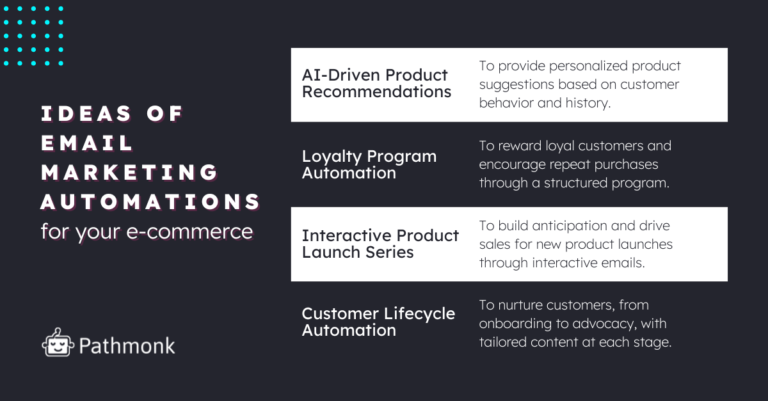
Picture this: you’ve spent countless hours perfecting your e-commerce site, curating the best products, optimizing for SEO, and investing in ads. And yet, your sales aren’t exactly skyrocketing. Sound familiar?
If that’s the case, there’s a tool in your arsenal that might not be getting the attention it deserves: email marketing. While some marketers consider this an outdated and friction-creating channel, it’s incredibly powerful when done right.
Here’s a fun fact to get us started: Email marketing generates an impressive ROI when compared to other channels. For every $1 spent, the average return is $36 to $45, depending on the industry (FormRush). Yes, you read that right! Imagine how much potential you could be wasting for not doing it correctly.
So, on top of guiding you through creating the perfect email marketing strategy for your e-commerce, we will give you original ideas of automations you can create for your business and the secret to using AI to optimize your data analytics and provide even more personalized email marketing experiences – I guarantee you won’t find it anywhere else 🤫
So, let’s unpack how we can leverage email marketing, with a sprinkle of analytics and data-driven insights, to boost your e-commerce sales.
Table of Contents
The Reality of Email Marketing for E-commerce
Before we dive in step-by-step, let’s address why email marketing is so crucial for e-commerce. In an industry that’s fiercely competitive, standing out can be tough. But email marketing gives you a direct line to your customers – one that’s personal, targeted, and cost-effective.
Direct Access to Customers
Think of email marketing as having a VIP pass to your customer’s inbox. Unlike social media or paid ads, where algorithms decide who sees your content, emails go straight to the recipient. This direct access allows you to maintain a consistent presence in your customers’ lives, nurturing relationships and driving repeat business.
Building Customer Loyalty
Regular, value-driven emails help build trust and loyalty. Whether it’s through exclusive discounts, sneak peeks of new products, or personalized recommendations, email marketing keeps your brand top-of-mind, encouraging repeat purchases and long-term loyalty.
Measurable and Scalable
One of the biggest advantages of email marketing is its measurability. You can track open rates, click-through rates, and conversions to gauge the success of your campaigns. This data-driven approach enables you to refine your strategy, making it more effective over time.
The Ultimate Guide to Applying Email Marketing for E-commerce
1. Building a Robust Email List
First things first, you need an email list. But not just any list – a robust, engaged one. It’s like the difference between having a crowded party where no one’s having fun and an intimate gathering with lively conversations. Quality over quantity, my friends.
Segmentation is Key
Not all customers are created equal. Some might be loyal fans who purchase regularly, while others might only shop during sales. Segmenting your audience based on behavior, preferences, and purchase history allows you to send more targeted and relevant emails. Tools like Google Analytics and CRM platforms can help you gather and analyze this data.
For example, if you notice a segment of customers who frequently buy running shoes, you can create an email campaign around new arrivals in athletic wear or exclusive discounts on their favorite brands.
Predictive Analytics
Predictive analytics takes things a step further by using historical data to predict future behavior. This can help you anticipate what products a customer might be interested in next, or when they are likely to make a purchase. Platforms like Adobe Analytics and IBM Watson offer predictive analytics features that can be incredibly beneficial for e-commerce businesses.
Imagine being able to send a timely email to a customer right before they’re about to run out of their favorite skincare product. It’s like having a crystal ball, but way cooler and less mystical.
2. Crafting Compelling Content
Once you have a solid list, the next step is to craft emails that your subscribers actually want to read. This is where data analytics comes into play.
Subject Lines
Your subject line is the first thing recipients see, so make it count. It should be intriguing yet clear about what the email contains. Avoid clickbait; nobody likes being tricked. Personalizing the subject line with the recipient’s name or mentioning a product they like can increase open rates.
Personalization Beyond the First Name
Personalization isn’t just about inserting the recipient’s first name. Dive deeper into their preferences. Use data to tailor product recommendations, send birthday wishes with a special discount, or follow up on abandoned carts with the exact items they left behind.
A/B Testing for the Win
Not sure if your subject line is catchy enough? Test it. A/B testing allows you to experiment with different versions of your emails to see what resonates best with your audience. Maybe it’s a quirky subject line, or perhaps a straightforward approach works better. Let the data guide you.
3. Leveraging Analytics for Insights
You can’t improve what you don’t measure. Here’s where analytics becomes the backbone of your email marketing strategy.
Open and Click-Through Rates
These are your bread and butter metrics. Analyzing open rates tells you how well your subject lines and send times are working, while click-through rates indicate how engaging your content is. If your click-through rate is low, it’s time to rethink your call-to-action (CTA) or the overall email design.
Conversion Rates and ROI
Ultimately, you want your emails to convert. Track which emails lead to sales, and calculate the ROI for your campaigns. This helps you understand what’s working and what’s not, allowing you to refine your strategy over time.
Understand your customer journey analytics
See how your users behave, find drop-offs, and receive actionable insights with AI.

4. Automating Your Campaigns
Automation is the key for scaling your email marketing efforts without losing your mind.
Welcome Series
First impressions matter. Set up an automated welcome series to introduce new subscribers to your brand, highlight key products, and offer a small discount to encourage their first purchase.
Abandoned Cart Reminders
Did you know that nearly 70% of online shopping carts are abandoned? Automated reminders can help recover some of that lost revenue. Send a series of emails nudging the customer to complete their purchase, and consider offering an additional discount as a final push.
Post-Purchase Follow-ups
Don’t stop communicating after the sale. Automated post-purchase emails can thank the customer, ask for feedback, and recommend related products. This not only fosters loyalty but also encourages repeat purchases.

5. Engaging Your Audience
Don’t see your e-mail activities only as a sales channel, look at it as community engagement as well. Engage with your audience to build a relationship.
Interactive Content
Incorporate polls, surveys, and user-generated content in your emails. This not only makes your emails more engaging but also provides you with valuable insights about your customers.
Storytelling
People love stories. Share behind-the-scenes looks at your business, customer success stories, or the journey of how a product is made. This humanizes your brand and creates a deeper connection with your audience.
6. Optimizing for Mobile
With over half of all emails opened on mobile devices, it’s crucial to ensure your emails are mobile-friendly. Use responsive design templates, keep your text concise, and make sure your CTA buttons are large enough to tap easily.
7. Staying Compliant
Last but not least, ensure you’re complying with email marketing laws and regulations like GDPR and CAN-SPAM. Provide a clear unsubscribe link, avoid misleading subject lines, and honor all opt-out requests promptly.
Original Ideas of Email Marketing Automations for Your E-commerce
AI-Driven Product Recommendations
Objective: To provide highly personalized product suggestions based on customer behavior and purchase history.
How it works:
- AI integration: use AI to analyze customer data, including browsing behavior, purchase history, and preferences.
- Email 1 (personalized recommendations): send an email featuring products specifically recommended for the customer based on their past interactions.
- Email 2 (complementary products): a follow-up email suggesting complementary products to their recent purchases.
- Email 3 (new arrivals & trending): highlight new arrivals or trending products that align with their shopping patterns.
Loyalty Program Automation
Objective: To reward loyal customers and encourage repeat purchases through a structured loyalty program.
How it works:
- Email 1 (enrollment confirmation): Welcome email confirming their enrollment in the loyalty program, detailing the benefits and how to earn points.
- Email 2 (point balance update): Monthly update on their points balance, including suggestions on how to redeem points for rewards.
- Email 3 (exclusive offers for members): Special discounts or early access to sales exclusively for loyalty program members.
- Email 4 (milestone rewards): Notify customers when they reach a new loyalty milestone, offering them a unique reward or bonus points.
Interactive Product Launch Series
Objective: To build anticipation and drive sales for new product launches through a series of interactive and engaging emails.
How it works:
- Email 1 (teaser campaign): send a teaser email with a countdown to the product launch, including sneak peeks and teaser images.
- Email 2 (behind-the-scenes): share behind-the-scenes content about the making of the product, including interviews with designers or product developers.
- Email 3 (interactive quiz): engage customers with an interactive quiz related to the new product, leading them to discover the product’s unique features.
- Email 4 (launch day): announce the product launch with a special offer for early buyers and a direct link to the product page.
Customer Lifecycle Automation
Objective: To nurture customers throughout their lifecycle, from onboarding to advocacy, with tailored content at each stage.
How it works:
- Email 1 (welcome and onboarding): welcome new customers with an onboarding guide that includes tips on how to get the most out of your products.
- Email 2 (first purchase celebration): celebrate their first purchase with a thank-you email and a discount on their next order.
- Email 3 (usage tips and tricks): share usage tips, tutorials, or hacks for the products they’ve purchased, enhancing their user experience.
- Email 4 (advocacy encouragement): encourage satisfied customers to share their experiences on social media or refer friends for additional rewards.

Measure the Impact of Email Marketing on Your Conversation Rates with AI
When using multiple channels, it’s easy to lose track of important data and miss insights that might determine the success or failure of your next campaigns. To specifically measure the impact of email marketing, it’s crucial to track campaigns effectively.
Tools like Pathmonk allow you to monitor the performance of specific email campaigns from the initial click to the final conversion, examining how email visitors move through the conversion funnel and identifying stages where visitors are most likely to drop off. This granular tracking helps you understand which campaigns are driving the most engagement and sales, providing clear insights into your email marketing’s effectiveness.
By knowing where your customers are on their buying journey, Pathmonk allows personalized website experiences based on AI analysis, showing specific contents that are more likely to convert that visitor. With an optimized email marketing strategy and AI-powered analytics with Pathmonk, you have the dream team!
Increase +180%
leads
demos
sales
bookings
from your website with AI
Get more conversions from your existing website traffic delivering personalized experiences.

Email marketing in e-commerce, when powered by data and analytics, is a potent tool for increasing sales. From building and segmenting your list to crafting compelling content and leveraging automation, each step is crucial.
It’s about understanding your customers through data, creating personalized and engaging content, and continuously optimizing your efforts. Plus, by leveraging analytics and website data with Pathmonk, you can craft e-mail campaigns that not only increase sales and customer experience, but also build lasting relationships with your customers. What are you waiting for? Book a guided tour with our team today!
And now you know, next time someone tells you email marketing is dead, give them a little pawl on the back and say: “If you think that, you’re probably doing it wrong” 👀
Happy emailing!





